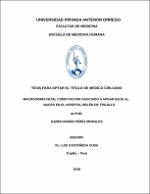Mostrar el registro sencillo del ítem
Macrosomía fetal como factor asociado a apgar bajo al nacer en el Hospital Belén de Trujillo
| dc.contributor.advisor | Castañeda Cuba, Luis Enrique | |
| dc.contributor.author | Pérez Morales, Karen Ingrid | |
| dc.creator | Pérez Morales, Karen Ingrid | |
| dc.date.accessioned | 2019-07-01T21:50:45Z | |
| dc.date.available | 2019-07-01T21:50:45Z | |
| dc.date.issued | 2019 | |
| dc.identifier.uri | https://hdl.handle.net/20.500.12759/5024 | |
| dc.description.abstract | Objetivo: Determinar si la macrosomía fetal está asociada a Apgar bajo al nacer en el Hospital Belén de Trujillo. Material y métodos: Se llevó a cabo un estudio retrospectivo de casos y controles en el que se incluyeron a 132 neonatos, según criterios de selección los cuales se dividieron en 2 grupos: neonatos con Apgar bajo al nacer y neonatos con Apgar normal; aplicándose el odds ratio y la prueba estadística chi cuadrado. Resultados: Las frecuencias de multiparidad y edad gestacional postérmino fueron significativamente mayores en el grupo de pacientes con Apgar bajo al nacer respecto al grupo de pacientes con Apgar normal. La frecuencia de macrosomía fetal en neonatos con Apgar bajo al nacer fue de 24%. La frecuencia de macrosomía fetal en neonatos sin Apgar bajo al nacer fue de 9%. La macrosomía fetal como factor de riesgo para Apgar bajo al nacer en neonatos con un odds ratio de 3.2 el cual fue significativo (p<0.05). En el análisis multivariado se corrobora la significancia del riesgo para las variables macrosomía fetal, gestación postérmino y multiparidad como factores de riesgo para Apgar bajo al nacer. Conclusión: La macrosomía fetal está asociada a Apgar bajo al nacer en el Hospital Belén de Trujillo. | es_PE |
| dc.description.abstract | Objective: To determine whether fetal macrosomia is associated with low Apgar at birth in the Bethlehem Hospital of Trujillo. Material and methods: A retrospective case-control study was carried out in which 132 neonates were included, according to selection criteria which were divided into 2 groups: neonates with Apgar low at birth and neonates with normal Apgar; applying the odds ratio, and the chi square statistical test. Results: The frequencies of multiparity and gestational age postermino were significantly higher in the group of patients with low Apgar at birth with respect to the group of patients with normal Apgar. The frequency of fetal macrosomia in neonates with low Apgar at birth was 24%. The frequency of fetal macrosomia in neonates without Apgar low at birth was 9%. Fetal macrosomia as a risk factor for low Apgar at birth in neonates with an odds ratio of 3.2 which was significant (p <0.05). In the multivariate analysis, the significance of the risk for the variables fetal macrosomia, postermino gestation and multiparity as risk factors for low Apgar at birth is corroborated. Conclusion: Fetal macrosomia is associated with low Apgar at birth in the Bethlehem Hospital of Trujillo. | en_US |
| dc.description.uri | Tesis | es_PE |
| dc.format | application/pdf | es_PE |
| dc.language.iso | spa | es_PE |
| dc.publisher | Universidad Privada Antenor Orrego - UPAO | es_PE |
| dc.relation.ispartofseries | T_MED.HUMA_2576 | |
| dc.rights | info:eu-repo/semantics/openAccess | es_PE |
| dc.source | Universidad Privada Antenor Orrego | es_PE |
| dc.source | Repositorio Institucional - UPAO | es_PE |
| dc.subject | Macrosomía fetal | es_PE |
| dc.subject | Apgar bajo al nacer | es_PE |
| dc.subject | Morbimortalidad neonatal | es_PE |
| dc.title | Macrosomía fetal como factor asociado a apgar bajo al nacer en el Hospital Belén de Trujillo | es_PE |
| dc.type | info:eu-repo/semantics/bachelorThesis | es_PE |
| thesis.degree.level | Título Profesional | es_PE |
| thesis.degree.grantor | Universidad Privada Antenor Orrego. Facultad de Medicina Humana | es_PE |
| thesis.degree.name | Médico Cirujano | es_PE |
| thesis.degree.discipline | Medicina Humana | es_PE |
Ficheros en el ítem
Este ítem aparece en la(s) siguiente(s) colección(es)
-
Medicina Humana [2739]

